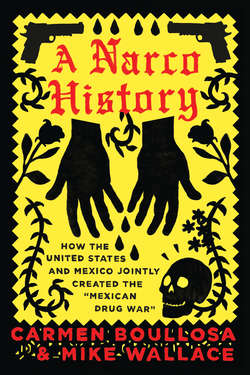Читать книгу A Narco History - Carmen Boullosa - Страница 10
ОглавлениеDuring World War II, Sinaloan opium output rose dramatically. Some say the U.S. prevailed on the Mexican government to give free rein to gomeros in order to procure morphine for wounded soldiers, the traditional supply line from Turkey having been severed. Others insist there is no evidence of such a deal, but agree that the trade certainly bloomed, as did the production of hemp, great quantities of which were needed for rope and cordage and other uses. Marijuana output declined after the war, but the opium trade continued to flourish into the fifties, and indeed its operators began to descend from their former mountain fastness. To market their crop, campesino entrepreneurs set up shop in Culiacán, capital of Sinaloa. Violent confrontations began to emerge between traffickers, or against the police, the town becoming (local papers worried) “a new Chicago with gangsters in sandals.”
Partly in response to provincial disorder, partly heeding U.S. complaints about the post-war growth in drug trafficking, the PRI—under President Miguel Alemán (1946–1952)—broke with Cárdenas’ public health approach and moved decisively toward a punitive prohibitionist regime, and one, moreover, that gathered law enforcement into federal hands. In 1947, Miguel Alemán moved anti-drug enforcement into the PGR, the Procuraduría General de la República (attorney general’s office) and its subsidiary enforcement arm the Policía Judicial Federal (Federal Judicial Police [PJF]).
It quickly became apparent, however, that PRI honchos and their PGR agents had no intention of striving to eliminate the drug business. Rather they adopted a centralized version of what local caciques had been doing, establishing something of a public-private partnership. The federal police would take over the business of riding herd on narcotic operators—coordinating, steering, and containing their increasing propensity to compete by violent means. At the same time (a far from merely incidental benefit) they would generate a regular income for the state while also providing for their own pockets and for those of their PGR superiors, and so on up the ladder to the political authorities near or at the apex of the party structure. The PRI would seek not to extirpate but regulate—to establish a (profitable) “Pax Priista.”
In the same year, 1947, and largely at the instigation of U.S. authorities, the Miguel Alemán government created the DFS (Dirección Federal de Seguridad or National Security Directorate) which was part political police, part national security agency. Something of a cross between the FBI and the then newly minted CIA, it would work particularly closely with the latter, a token of Mexico’s alignment with the U.S. in the emerging Cold War. The CIA would come to count on DFS spies to provide it with information on the doings of Soviet, Eastern Bloc, and, later, Cuban officials in Mexico. The PRI would employ it as a domestic secret police, tasked with surveillance and repression of dissidents, populists, unionists, Marxists, communists, and other “subversives.”
The DFS quickly strayed into PGR territory, using anti-drug operations as a device for quelling social movements and PRI political adversaries. The DFS also became actively complicit in regulating and profiting from the flow of narcotics to the United States. Colonel Carlos Serrano, a PRI senator and close friend and adviser of President Alemán, had been instrumental (notes Stephen Niblo) in creating the DFS and retained considerable power over its operations. He was believed by the CIA to be “an unscrupulous man, [who] is actively engaged in various illegal enterprises such as the narcotics traffic,” though this was no bar to the CIA’s working with him. The actual head of the DFS, Colonel Marcelino Inurreta (who had been trained by the FBI), and his top deputies were suspected by the U.S. State Department of being deeply involved in moving marijuana and opium.
In 1948, the Mexican government announced a “Great Campaign” to destroy illegal poppy plants. Police agents—supported for the first time by a contingent of soldiers—launched the effort in Sinaloa. During the 1950s the campaign was extended into Baja California, Sonora, Jalisco, Durango, Morelos, Guanajuato, and the Yucatán. Measured against its putative eradicationist goal, the campaign was largely ineffectual. The illegal plantations were scattered over a vast territory and growers who were discovered often bribed officials to leave their crops alone. But the effects of the campaign were nevertheless sweeping. The federal state had succeeded in prying drug policy enforcement from the hands of local caciques, drawn it to the national level, and shown drug dealers exactly who was their new boss. This had the additional if unintended consequence of centralizing the drug trade as well. Local traffickers soon realized that survival and prosperity now depended not only on winning protection from municipal and state authorities but required coming to terms with federal forces—the federal police, the military, the DFS, and PRI officials. That in turn required agglomerating into larger organizations, and expanding their horizons beyond the Sinaloan heartland to embrace the entire country.
